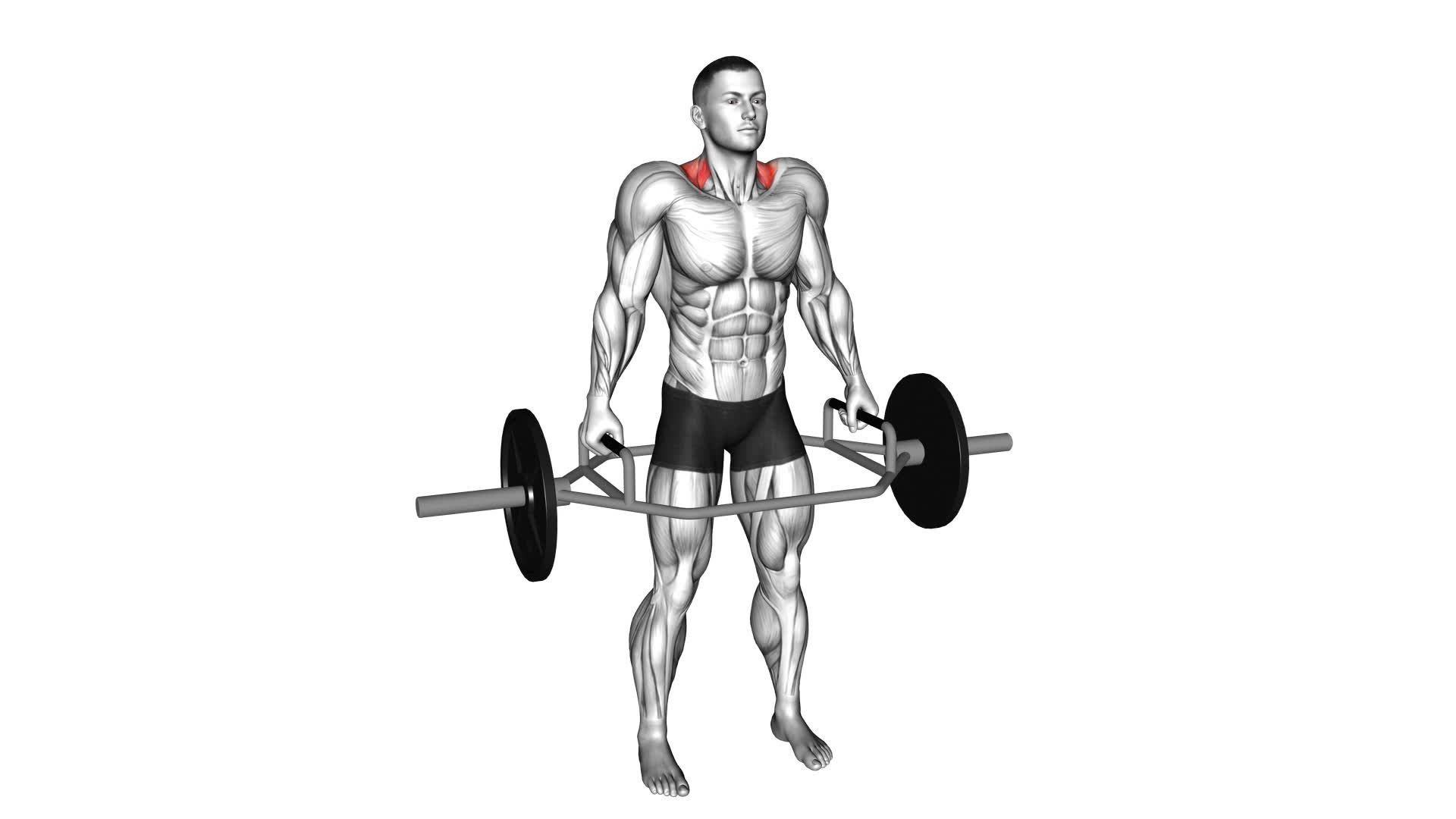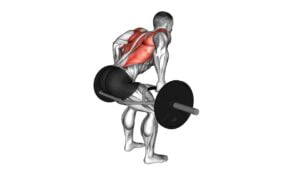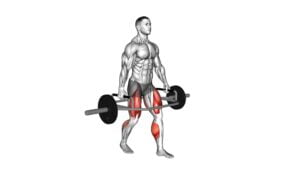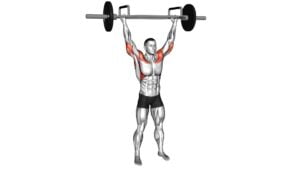Trap Bar Standing Shrug (male) – Video Exercise Guide & Tips

Looking to strengthen your traps and build upper body strength? Check out this video exercise guide and learn how to perform the trap bar standing shrug.
Watch This Exercise Video
In this active and informative tutorial, you'll discover the proper set-up, step-by-step instructions, and common mistakes to avoid.
Plus, we'll share tips for maximizing the effectiveness of this exercise and show you variations and advanced techniques for progression.
Get ready to take your trap bar shrugs to the next level!
Key Takeaways
- The Trap Bar Standing Shrug enhances upper body strength.
- This exercise increases muscle activation in the trapezius, deltoids, and rhomboids.
- It helps improve posture and shoulder stability.
- Utilizing proper equipment and form, such as a hexagonal trap bar and a comfortable grip, is important for maximizing the benefits of this exercise.
Benefits of the Trap Bar Standing Shrug
You will experience enhanced upper body strength and muscle development when performing the Trap Bar Standing Shrug. This exercise specifically targets your trapezius muscles, which are responsible for shoulder elevation and stability. By engaging these muscles, you can improve your posture and prevent shoulder injuries.
One of the main benefits of the Trap Bar Standing Shrug is increased muscle activation. This exercise activates not only the trapezius muscles but also the deltoids and rhomboids. The deltoids are responsible for shoulder abduction and flexion, while the rhomboids assist in retracting and rotating the scapulae. By targeting these muscles, you won't only strengthen and tone your upper body but also improve your overall shoulder stability.
Additionally, the Trap Bar Standing Shrug can help improve your grip strength. Since you'll be holding onto the trap bar during the exercise, your forearms and hand muscles will be engaged. This can be particularly beneficial for athletes who rely on grip strength, such as climbers or weightlifters.
In summary, the benefits of the Trap Bar Standing Shrug include:
- Enhanced upper body strength
- Increased muscle activation in the trapezius, deltoids, and rhomboids
- Improved posture
- Shoulder stability
- Grip strength
Incorporating this exercise into your routine can help you achieve a well-rounded upper body workout.
Proper Set-up and Equipment for the Exercise
Get ready to set up and gather the necessary equipment for the Trap Bar Standing Shrug exercise. Here are some set up tips and the necessary equipment you'll need:
- Trap Bar: Make sure you have access to a trap bar, also known as a hex bar. This specialized barbell has a hexagonal shape and allows for a more comfortable and natural grip during the exercise. Using a trap bar will help you maintain proper form and prevent strain on your wrists.
- Weight Plates: Load the trap bar with the appropriate amount of weight plates to challenge yourself during the exercise. Start with a weight that's manageable for you, and gradually increase as you become stronger. Remember to secure the weight plates onto the trap bar properly to ensure safety during the exercise.
- Lifting Straps (Optional): If you find it difficult to grip the trap bar for an extended period or if your grip strength is limiting your performance, consider using lifting straps. These straps can help you maintain a secure grip on the bar, allowing you to focus more on the movement rather than worrying about your grip.
Step-by-Step Guide to Performing the Trap Bar Standing Shrug
To properly perform the Trap Bar Standing Shrug exercise, begin by standing with the trap bar in front of you. Follow these step-by-step instructions to ensure proper execution of the exercise:
- Stand with your feet shoulder-width apart and your knees slightly bent.
- Bend at the hips and grasp the handles of the trap bar with an overhand grip.
- Keep your back straight and your chest up.
- Lift the trap bar by extending your hips and knees, keeping your arms straight.
- Once you're fully standing, shrug your shoulders up towards your ears, squeezing your traps.
- Hold for a brief pause at the top of the movement.
- Slowly lower the trap bar back down to the starting position.
- Repeat for the desired number of repetitions.
The Trap Bar Standing Shrug primarily targets the trapezius muscles, which are located in your upper back and neck. It also engages the deltoids, rhomboids, and erector spinae muscles. This exercise is great for improving upper body strength and posture.
Now that you know how to perform the Trap Bar Standing Shrug correctly, let's move on to the next section, which will discuss common mistakes to avoid during the exercise.
Common Mistakes to Avoid During the Exercise
To avoid common mistakes during the Trap Bar Standing Shrug exercise, it's important to maintain proper form and technique throughout the movement. Here are three technique tips to help you avoid these common mistakes and get the most out of your workout:
- Avoid using momentum: One common mistake is using momentum to lift the weight instead of relying on the muscles in your shoulders and upper back. To prevent this, focus on lifting the weight with control and using a slow and deliberate motion. This will ensure that you're properly engaging the targeted muscles and maximizing the effectiveness of the exercise.
- Keep your shoulders down: Another mistake is allowing your shoulders to shrug upwards as you lift the weight. This can put unnecessary strain on your neck and reduce the effectiveness of the exercise. Instead, focus on keeping your shoulders down and pulling them back as you lift the weight. This will help to engage the correct muscles and prevent any discomfort or potential injury.
- Maintain a neutral spine: It's important to keep your spine in a neutral position throughout the exercise. Avoid rounding or arching your back, as this can lead to spinal issues and decrease the effectiveness of the movement. Engage your core muscles and focus on keeping your spine straight and aligned.
By following these technique tips, you can avoid common mistakes and ensure that you're performing the Trap Bar Standing Shrug exercise correctly. This will help you maximize the effectiveness of the exercise and achieve your fitness goals.
Now, let's move on to some tips for maximizing the effectiveness of the trap bar standing shrug.
Tips for Maximizing the Effectiveness of the Trap Bar Standing Shrug
To maximize the effectiveness of the trap bar standing shrug, focus on utilizing proper form and technique. This will ensure that you're targeting your trapezius muscles effectively and maximizing traps growth. Here are some tips to help you get the most out of this exercise.
- First, make sure to maintain a neutral spine throughout the movement. Avoid rounding your back or shrugging your shoulders forward. This will help ensure that the tension is placed on your traps and not on other muscles.
- Second, engage your traps by actively squeezing your shoulder blades together at the top of the movement. This will help to fully activate your traps and enhance their growth.
- Next, choose an appropriate rep range for trap bar shrugs. Aim for 8-12 reps per set to maximize muscle growth. This rep range allows for sufficient overload while still maintaining good form and technique.
- Lastly, focus on the mind-muscle connection. Visualize your traps working and actively engage them during the exercise. This will help you to better isolate and target the muscles, leading to better results.
Variations and Advanced Techniques for Progression
To progress and challenge yourself with the Trap Bar Standing Shrug, there are a few key variations and advanced techniques you can incorporate into your routine.
One option is to gradually increase the weight increments you use, allowing you to continuously push your limits.
Another technique is to vary the tempo of your shrugs, incorporating slow and controlled movements or explosive and powerful ones for added challenge.
Additionally, modifying your grip width can target different muscle groups and provide a new stimulus for growth.
Adding Weight Increments
Increase the weight gradually to challenge yourself and progress with the Trap Bar Standing Shrug exercise. Adding weight to your workout routine is essential for building strength and muscle. Here are three technique modifications you can make to effectively add weight to your Trap Bar Standing Shrug:
- Increase the weight by adding additional plates to the trap bar. Start with a weight that you can comfortably lift for the desired number of repetitions and gradually increase the weight as you get stronger.
- Use weight increments that are challenging but manageable. Avoid adding too much weight at once, as it can compromise your form and increase the risk of injury. Gradually increase the weight by small increments to ensure proper technique and progression.
- Incorporate progressive overload principles. This involves gradually increasing the weight, sets, or reps over time to continually challenge your muscles and promote growth. Keep track of your progress and aim to increase the weight or reps each week or every few weeks.
Tempo Variations for Challenge
To further challenge yourself and continue progressing with the Trap Bar Standing Shrug exercise, try incorporating tempo variations for added difficulty and advanced technique.
Tempo variations involve manipulating the speed at which you perform the exercise, which can significantly increase the intensity and effectiveness of the movement.
One way to do this is by slowing down the eccentric (lowering) phase of the shrug, taking 2-3 seconds to lower the weight instead of letting it drop quickly. This forces your muscles to work harder and increases time under tension, leading to greater muscle growth and strength gains.
Another option is to perform explosive concentric (lifting) movements, focusing on explosive power and speed. This recruits more muscle fibers and enhances power output.
Incorporating these tempo variations into your Trap Bar Standing Shrug routine will provide a new challenge and help you achieve greater results.
Grip Width Modifications
To progress further with the Trap Bar Standing Shrug and continue challenging yourself, you can modify your grip width, which allows for variations and advanced techniques to enhance your progression.
Here are three grip width modifications to incorporate into your routine:
- Narrow Grip: By bringing your hands closer together on the trap bar, you increase the demand on your grip strength. This variation targets the forearm muscles and helps develop a stronger grip.
- Wide Grip: Conversely, widening your grip on the trap bar shifts the emphasis onto your upper back and shoulders. This modification challenges your shoulder stability and increases the range of motion for a more intense workout.
- Alternating Grip: Another option is to use an alternating grip, with one hand facing forwards and the other facing backwards. This grip variation helps to improve grip strength and can also assist with lifting heavier weights.
Incorporating these grip width modifications into your Trap Bar Standing Shrug routine not only enhances your grip strength but also provides alternative shoulder exercises to add variety and challenge to your workouts.
Frequently Asked Questions
How Much Weight Should I Use for the Trap Bar Standing Shrug?
To determine how much weight to use for the trap bar standing shrug, consider your current strength level and goals. Start with a weight that challenges you but allows you to maintain proper form throughout the exercise.
Focus on using the trap bar standing shrug variations that suit your needs, such as using a narrow or wide grip. Remember to engage your traps and lift the weight with controlled movements for optimal results.
Can I Perform the Trap Bar Standing Shrug Without a Trap Bar?
You can perform alternative exercises if you don't have access to a trap bar for the standing shrug. However, it's important to note that the trap bar offers unique benefits for this exercise. It allows for a more natural grip and reduces strain on the shoulders.
The trap bar also targets the trapezius muscles effectively. If you don't have a trap bar, you can try using dumbbells or a barbell to perform shrugs instead.
How Often Should I Include Trap Bar Standing Shrugs in My Workout Routine?
To determine the optimal workout frequency for including trap bar standing shrugs, consider your overall training goals and current routine.
These shrugs are a great exercise for targeting the traps, but if you don't have access to a trap bar, there are alternative options like dumbbell shrugs or barbell shrugs.
It's recommended to include trap bar standing shrugs 1-2 times a week, ensuring enough rest and recovery between sessions for optimal muscle growth and development.
Can the Trap Bar Standing Shrug Help Improve My Posture?
The trap bar standing shrug can definitely help improve your posture. By strengthening the muscles in your shoulders and upper back, this exercise can promote better alignment and reduce slouching. It also targets the trapezius muscles, which play a key role in maintaining good posture.
To properly execute this exercise, start by standing tall with a slight bend in your knees. Hold the trap bar with an overhand grip and lift your shoulders up towards your ears, squeezing them at the top. Focus on keeping your back straight throughout the movement.
Are There Any Specific Warm-Up Exercises I Should Do Before Performing the Trap Bar Standing Shrug?
Before performing the trap bar standing shrug, it's important to do dynamic warm-up exercises to prepare your muscles. This will help prevent injury and improve your performance.
Incorporating trap bar standing shrugs into your routine has many benefits, such as strengthening your upper back and shoulders, improving posture, and increasing grip strength.
Conclusion
The trap bar standing shrug is a beneficial exercise for strengthening and developing the upper traps. With proper set-up and equipment, this exercise can be performed effectively to target the desired muscles. Avoiding common mistakes and following tips for maximizing effectiveness will ensure optimal results.
Additionally, variations and advanced techniques can be incorporated to progress in this exercise. Incorporating the trap bar standing shrug into your workout routine can help improve overall upper body strength and posture.

Author
Years ago, the spark of my life’s passion ignited in my mind the moment I stepped into the local gym for the first time. The inaugural bead of perspiration, the initial endeavor, the very first surge of endorphins, and a sense of pride that washed over me post-workout marked the beginning of my deep-seated interest in strength sports, fitness, and sports nutrition. This very curiosity blossomed rapidly into a profound fascination, propelling me to earn a Master’s degree in Physical Education from the Academy of Physical Education in Krakow, followed by a Sports Manager diploma from the Jagiellonian University. My journey of growth led me to gain more specialized qualifications, such as being a certified personal trainer with a focus on sports dietetics, a lifeguard, and an instructor for wellness and corrective gymnastics. Theoretical knowledge paired seamlessly with practical experience, reinforcing my belief that the transformation of individuals under my guidance was also a reflection of my personal growth. This belief holds true even today. Each day, I strive to push the boundaries and explore new realms. These realms gently elevate me to greater heights. The unique combination of passion for my field and the continuous quest for growth fuels my drive to break new ground.







